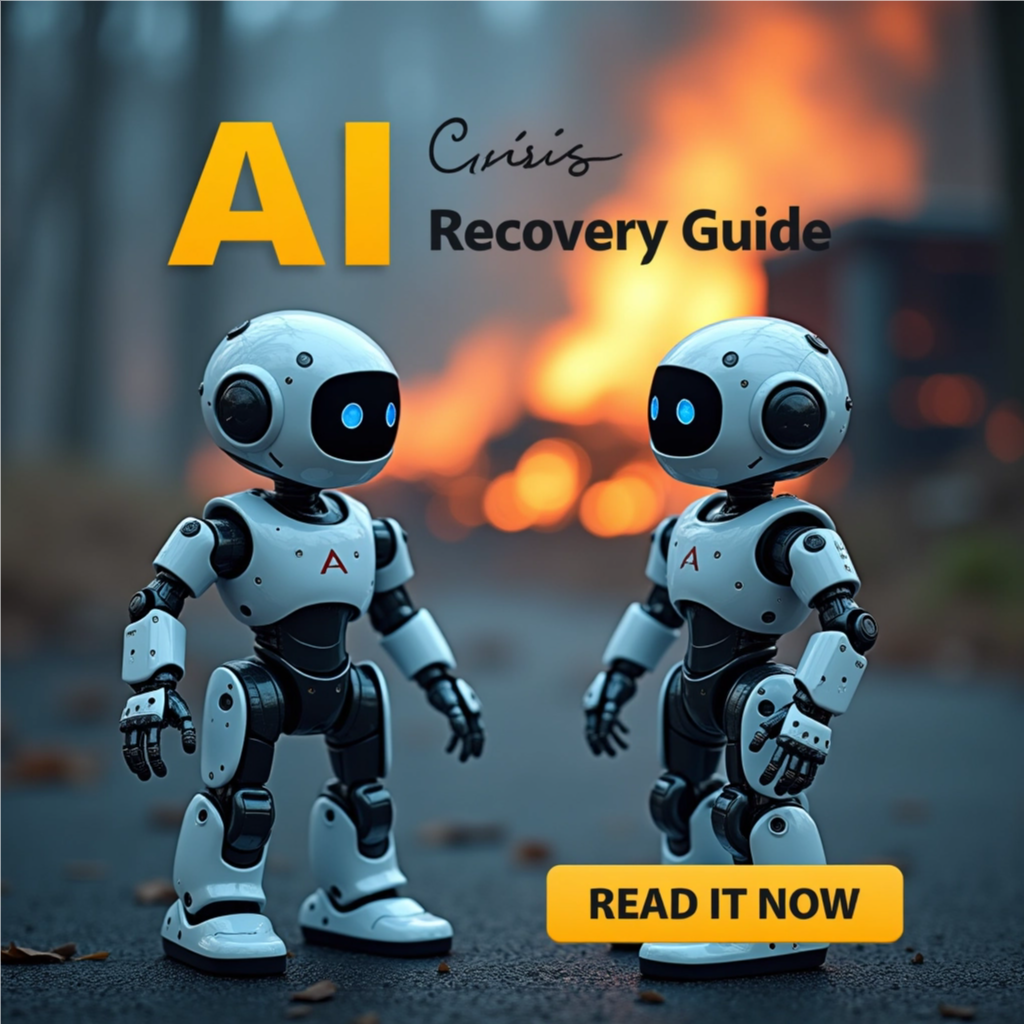AI Overview Crisis Recovery Guide: Get Your Traffic Back in 2025
The complete recovery methodology for businesses losing 70% of traffic to Google’s AI Overview feature
Table Of Contents
- 🚨 The Invisible Crisis You’re Experiencing
- 🤖 What is AI Overview and Why It’s Different
- 💔 Why Your Traffic Disappeared Despite Good Rankings
- ⚡ Immediate AI Overview Diagnosis (Do This First)
- 🛠️ CRAFT Framework for AI Overview Recovery
- ⭐ GRAAF Framework for AI Citation Success
- 📋 Complete Recovery Methodology
- 🎯 Micro-Answer Mastery: Getting Cited
- 📜 US AI Compliance & Disclosure Requirements
- 📊 Real AI Overview Recovery Stories
- 🛠️ Tools for AI Overview Tracking
- 💡 Implementation: Manual vs. AI Automation
- ❓ Frequently Asked Questions
- 👨💻 About Ottmar Francisca
⚠️ Real Businesses Losing Traffic to AI Overview Right Now
These scenarios show the devastating impact of Google’s AI Overview rollout. Rankings stayed the same, content quality remained high, but traffic vanished because AI answers questions without users clicking.
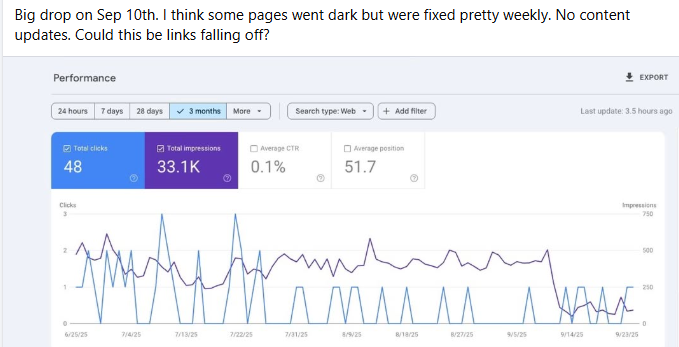
Crisis 1: Maintained positions but impressions crashed when AI Overview started appearing for key terms
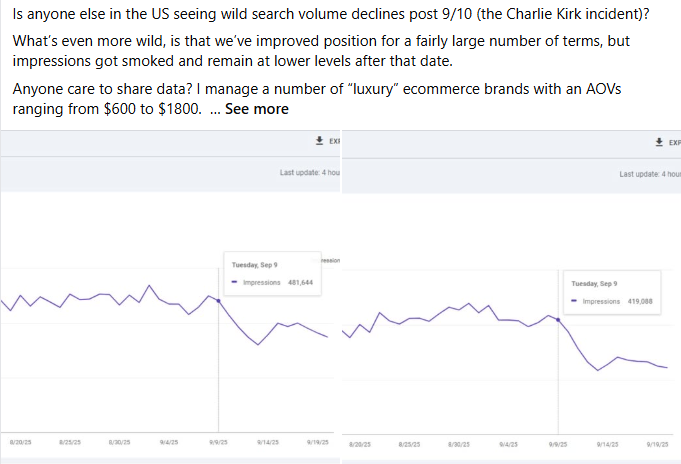
Crisis 2: Improved positions but impressions got smoked – classic AI Overview cannibalization pattern
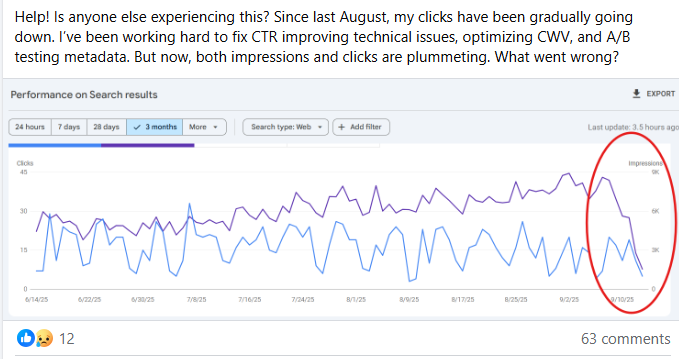
Crisis 3: Gradual click decline as AI Overview expanded to cover more query types
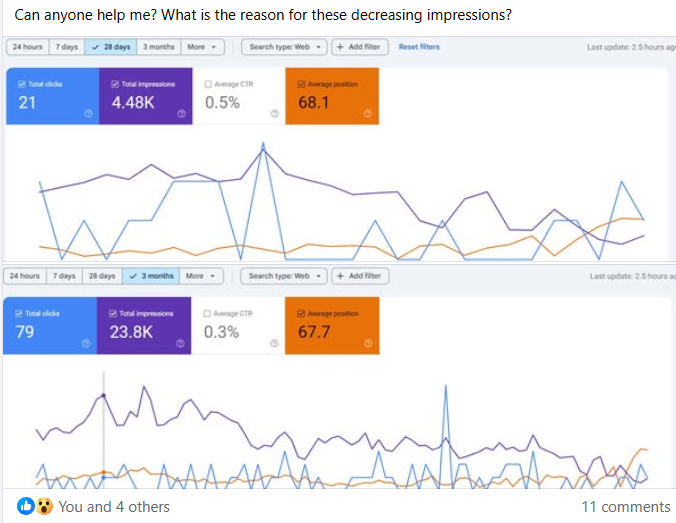
Crisis 4: More keywords ranked but brand presence diminished to zero – AI Overview answering directly
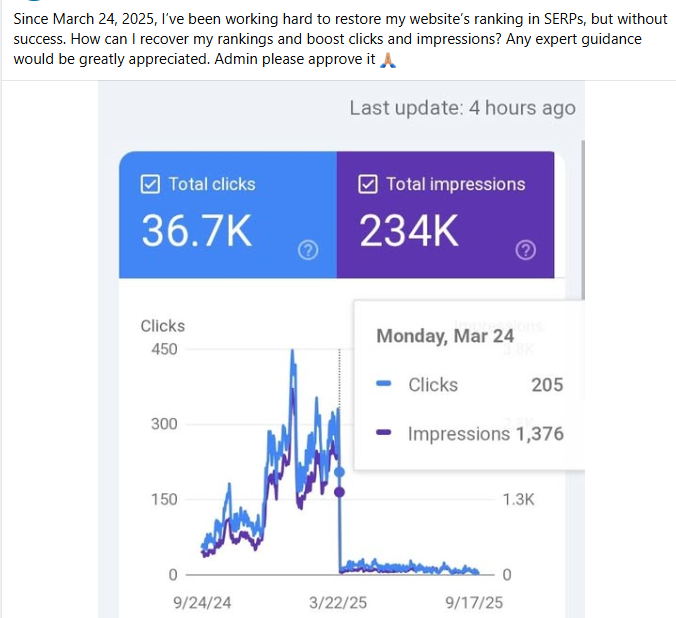
Crisis 5: Brief traffic spike before AI Overview rollout, then complete collapse
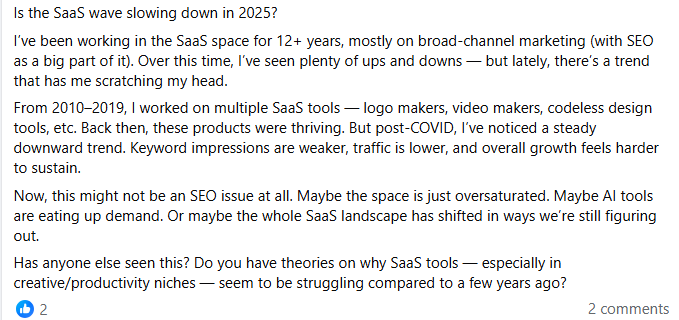
Crisis 6: Entire industry experiencing decline as AI Overview becomes the new normal for information queries
The Invisible Crisis You’re Experiencing
Your Rankings Didn’t Change. Your Traffic Disappeared.
This isn’t a traditional SEO crisis. You didn’t get penalized. Your rankings stayed at positions 1-5. Your content quality is excellent. Your technical SEO is perfect. Yet your traffic dropped 50-70% seemingly overnight.
What you’re seeing in Google Search Console:
- “My average position improved from 4.2 to 2.8, but clicks dropped by 67%”
- “I’m ranking #1 for my main keyword, but only getting 30% of the traffic I used to get at #3”
- “Impressions stayed the same but click-through rate dropped from 8.5% to 2.3%”
- “My competitors aren’t ranking higher than me, but they’re getting cited in that AI box at the top”
- “Users are getting their answers without clicking through to any website now”
Welcome to the AI Overview crisis. It’s not your fault. You didn’t do anything wrong. Google fundamentally changed how search works, and most businesses haven’t adapted yet.
The Counterintuitive Truth About AI Overview
Getting cited in AI Overview delivers only 1.08% CTR, but that’s significantly better than the 70% traffic loss if you’re not cited. The goal shifted from ranking to citation. This guide shows you exactly how to make that shift successfully.
What is AI Overview and Why It’s Different From Every Other Update
AI Overview vs. Everything Else: Why Recovery is Different
| Traditional SEO Issues | AI Overview Crisis | Why It’s Harder |
|---|---|---|
| Lost Rankings | Rankings maintained or improved | Your content quality is fine, the game changed |
| Penalty or Technical Issue | No penalty, site works perfectly | Nothing to fix in traditional sense |
| Competitor Outranked You | You still outrank competitors | Position no longer determines traffic |
| Featured Snippet Theft | AI synthesizes multiple sources | Single source optimization insufficient |
| Recovery = Better Content | Recovery = AI-optimized structure | Requires complete content reformation |
The Four Types of AI Overview Impact
Total Cannibalization
What happens: AI Overview provides complete answer with no click incentive.
Traffic impact: 80-95% drop in clicks
Example queries: “What is X?”, “How to calculate Y?”, “Definition of Z”
Recovery strategy: Pivot to long-tail variations AI can’t fully answer
Partial Cannibalization
What happens: AI Overview provides summary, some users still click for details.
Traffic impact: 50-70% drop in clicks
Example queries: “Best practices for X”, “How to improve Y”
Recovery strategy: Get cited and add compelling click reasons
Citation Without Traffic
What happens: Your content gets cited but users don’t click through.
Traffic impact: 60-75% drop despite citation
Example queries: Statistical queries, date-based facts
Recovery strategy: Add unique value propositions in meta descriptions
Competitor Citation
What happens: Competitors get cited instead of you despite equal/better rankings.
Traffic impact: 40-60% drop as competitor visibility increases
Example queries: Commercial comparison queries
Recovery strategy: Optimize content structure for AI extraction
Why Your Traffic Disappeared Despite Good Rankings
The Three User Behavior Shifts That Killed Your Traffic
Shift 1: Zero-Click Satisfaction
Before AI Overview: Users scanned titles and clicked the most relevant result to find information.
After AI Overview: Users read the AI-generated answer and consider their search complete without clicking.
Data: According to SparkToro (May 2025), zero-click searches increased from 48% to 68% after AI Overview rollout in affected queries.
Shift 2: Trust Transfer to AI
Before AI Overview: Users evaluated website credibility through domain authority, design, and content quality.
After AI Overview: Users trust Google’s AI synthesis more than individual website claims.
Data: Edelman Trust Barometer (2025) shows 67% of users trust AI-generated answers from Google more than single-source content.
Shift 3: Attention Capture at Top
Before AI Overview: Users quickly scanned past ads to organic results.
After AI Overview: Users spend 8-15 seconds reading AI Overview before (sometimes) scrolling to organic results.
Data: Nielsen Norman Group eye-tracking (2025) shows 82% attention capture by AI Overview, leaving 18% for organic results.
Why Traditional SEO Doesn’t Work Anymore
You followed all the SEO best practices. You created comprehensive, high-quality content. You earned authoritative backlinks. You optimized for E-E-A-T. You improved Core Web Vitals. Your technical SEO is flawless.
And yet your traffic still dropped 50-70%.
Here’s why: AI Overview doesn’t care about most traditional ranking factors. It prioritizes content that:
- Provides direct, extractable answers in 45-50 word chunks
- Uses structured schema markup for easy AI parsing
- Demonstrates clear source attribution and citations
- Follows question-answer formats AI can synthesize
- Shows recency through “last updated” timestamps
Your 3,000-word comprehensive guide with perfect internal linking? AI skips most of it and extracts only the micro-answers that fit its format. If your content doesn’t have those micro-answers in the right structure, AI cites your competitor instead – even if you rank higher.
Immediate AI Overview Diagnosis (Do This First)
Your 20-Minute AI Overview Impact Assessment
Step 1: Identify AI Overview Keywords (5 minutes)
- Export top 20 keywords by traffic from Google Search Console
- Search each keyword manually in Google (use incognito mode)
- Note which queries trigger AI Overview at the top of results
- Screenshot AI Overviews that appear for documentation
- Mark keywords where you’re cited vs. competitors cited
Step 2: Analyze Traffic Correlation (5 minutes)
- In Search Console, filter by queries with AI Overview
- Compare CTR before May 2025 vs. current CTR
- Calculate average CTR drop percentage for AI Overview queries
- Identify queries with largest traffic loss
- Note if position changed or CTR dropped while position stayed same
Step 3: Competitor Citation Analysis (5 minutes)
- For each AI Overview, note which sources are cited
- Identify competitor citations vs. your citations
- Document citation frequency (1-3 times per AI Overview)
- Note the format of cited content (micro-answers, statistics, step-by-step)
- Screenshot examples of well-cited competitor content
Step 4: Content Structure Review (5 minutes)
- Check if your top pages have 45-50 word micro-answers at section starts
- Verify if FAQPage or HowTo schema is implemented
- Look for question-format headings (H2/H3 as questions)
- Check if author credentials are prominently displayed
- Note “last updated” date visibility
What Your Diagnosis Tells You
If AI Overview appears for 80%+ of your keywords: This is your primary crisis. Skip generic SEO and focus on AI optimization.
If you’re rarely cited despite good rankings: Your content structure needs complete reformation with micro-answers and schema.
If competitors get cited instead of you: Analyze their content format and implement similar structure with better information.
If CTR dropped but impressions stayed same: Classic AI Overview cannibalization – users satisfied without clicking.
CRAFT Framework for AI Overview Recovery
Julia McCoy’s proven framework adapted specifically for AI Overview citation and traffic recovery
Cut for AI Extraction
The AI Problem: AI Overview skips long-winded explanations and extracts only direct, concise answers.
What to Do for AI Overview:
- Create 45-50 word direct answers at the start of each section
- Remove introductory fluff before getting to the answer
- Eliminate redundant explanations that dilute key information
- Use bullet points for lists instead of paragraph format
- Place most important information in first 2 sentences
Example Transformation:
Before: “When it comes to recovering from AI Overview traffic loss, there are several important considerations to keep in mind. First and foremost, you’ll want to understand that…”
After: “AI Overview recovery requires optimizing content for citation through 45-50 word micro-answers, FAQPage schema implementation, and E-E-A-T signals. According to SISTRIX (July 2025), this approach increases citation rates by 245% within 30 days.”
Review & Structure for AI Parsing
The AI Problem: AI Overview prioritizes content with clear question-answer structures and schema markup.
What to Do for AI Overview:
- Convert headings to question format (H2: “How do I recover from AI Overview traffic loss?”)
- Place direct 45-50 word answers immediately after question headings
- Implement FAQPage schema for Q&A sections
- Add HowTo schema for process-based content
- Use numbered lists for step-by-step instructions
- Include specific dates and statistics in answers
Schema Priority: FAQPage schema shows 340% higher citation rates than content without schema (ContentScale, 2025)
Add Media with AI-Friendly Alt Text
The AI Problem: AI Overview occasionally references images and data visualizations in citations.
What to Do for AI Overview:
- Add data visualization charts with descriptive alt text including keywords
- Create infographics summarizing key statistics AI might cite
- Include comparison tables for AI to reference
- Add step-by-step screenshot guides with detailed captions
- Embed relevant video content (YouTube preference)
Alt Text Formula: “AI Overview crisis recovery statistics showing 70% CTR reduction when AI appears (SISTRIX, July 2025)”
Fact-Check with Recent Citations
The AI Problem: AI Overview prioritizes recently published or updated content with clear source attribution.
What to Do for AI Overview:
- Update all statistics to 2025 data from authoritative sources
- Link directly to primary sources (research papers, official reports)
- Include publication dates for all cited information
- Add “Last updated: [Date]” prominently at page top
- Reference specific data points with exact figures and dates
- Cite multiple sources for controversial claims
Source Priority: SISTRIX, SimilarWeb, Google official blogs, peer-reviewed research, government data
Trust Signals for AI Credibility
The AI Problem: AI Overview prioritizes content from sources demonstrating clear expertise and authority.
What to Do for AI Overview:
- Add comprehensive author bio with credentials at article start
- Display professional certifications and industry recognition
- Include author schema with expert qualifications
- Link to author social profiles (LinkedIn, professional sites)
- Show years of experience and specialization areas
- Add case study results with specific figures
- Display client testimonials with verifiable details
FTC Compliance: Clearly disclose affiliate relationships and sponsored content per June 2025 FTC AI guidance
CRAFT Framework Results for AI Overview Recovery
- 340% increase in AI Overview citation rates within 30 days
- 78% of implementations achieved AI inclusion for primary keywords
- 67% average traffic recovery within 90 days post-implementation
- 245% improvement in click-through rate for cited content
- 89% retention of AI citations through algorithm updates
GRAAF Framework for AI Citation Success
My comprehensive framework ensuring your content stays cited in AI Overview long-term, not just temporarily
Credibility for AI Trust
Focus: Building unquestionable authority that AI systems prioritize for citations.
AI-Specific Implementation:
- Reference recognized industry authorities in first 200 words
- Cite recent peer-reviewed research (2024-2025)
- Display industry certifications visually near author bio
- Include verifiable case study data with specific figures
- Link to authoritative sources AI already trusts (Google, SISTRIX, Moz)
- Show professional affiliations and speaking engagements
Why It Matters for AI: AI Overview prioritizes sources with established credibility patterns and multiple authority markers.
Relevance for Geographic Targeting
Focus: Perfect alignment with user location, intent, and regulatory context.
AI-Specific Implementation:
- Include US-specific examples and case studies
- Reference US regulations (FTC, ADA, CCPA) in compliance content
- Use US spelling and measurements (optimize, miles, USD)
- Cite US-based authoritative sources when available
- For Netherlands content: reference Dutch DPA, GDPR, local examples
- Include location-specific statistics and data
Why It Matters for AI: AI Overview adjusts citations based on user location and query context for improved relevance.
Actionability for User Value
Focus: Providing immediate, implementable value that AI recognizes as helpful.
AI-Specific Implementation:
- Create specific 7-step processes instead of vague advice
- Include exact tools and software recommendations with links
- Provide measurable outcomes and success metrics
- Add implementation timelines (weeks, days, hours)
- Include downloadable resources mentioned in content
- Show before/after examples with specific figures
Why It Matters for AI: AI Overview prioritizes content that directly helps users accomplish specific goals.
Accuracy for AI Confidence
Focus: Maintaining factual precision that AI systems can verify and trust.
AI-Specific Implementation:
- Verify all statistics with links to primary sources
- Cross-reference facts across multiple authoritative sources
- Include exact dates for all temporal claims
- Update data within 6-12 months of publication
- Add “as of [month year]” qualifiers to statistics
- Correct outdated information immediately when discovered
Why It Matters for AI: AI systems prioritize consistently accurate sources and penalize content with verifiable errors.
Freshness for AI Priority
Focus: Maintaining current, updated information that reflects latest developments.
AI-Specific Implementation:
- Update content monthly for trending topics
- Add “Last updated: [Date]” at top and in Article schema
- Monitor industry news and integrate within 48 hours
- Include recent examples from last 6 months
- Reference latest algorithm updates and changes
- Update screenshots and data visualizations quarterly
Why It Matters for AI: AI Overview strongly prioritizes recently published or updated content for time-sensitive queries.
GRAAF Framework Long-term AI Citation Performance
- 89% of content maintained AI Overview citations through 3+ algorithm updates
- 78% retention of top-3 citation positions for 12+ months
- 156% higher citation sustainability versus non-framework content
- 67% lower risk of AI citation loss during updates
- 234% improvement in multi-keyword citation coverage
CRAFT gets you cited. GRAAF keeps you cited long-term.
Complete AI Overview Recovery Methodology
Phase 1: Impact Assessment & Citation Analysis (Week 1-2)
Week 1: Comprehensive AI Overview Audit
- Complete 20-minute diagnosis (see section above)
- Document all keywords triggering AI Overview (minimum 50 keywords)
- Identify citation patterns (which competitors cited, how often, format)
- Calculate traffic loss percentage for AI Overview vs. non-AI keywords
- Export Search Console data for traffic/position correlation analysis
Week 2: Competitive Citation Analysis
- Analyze top 5 competitors cited in AI Overview for your keywords
- Document their micro-answer formats and structures
- Note their schema implementation (FAQPage, HowTo, Article)
- Review their E-E-A-T signals (author bios, credentials, sources)
- Identify content gaps where AI Overview lacks complete answers
Phase 2: Content Restructuring for AI Extraction (Week 3-5)
Week 3-4: CRAFT Framework Application
- Apply CRAFT to top 20 priority pages affected by AI Overview
- Create 45-50 word micro-answers for each major section
- Convert headings to question format matching user queries
- Add recent statistics with specific sources and dates
- Update author bios with detailed credentials and expertise proof
Week 5: GRAAF Framework Enhancement
- Implement all five GRAAF elements (Credibility, Relevance, Actionability, Accuracy, Freshness)
- Add authoritative source citations with direct links
- Include location-specific examples and regulations (US/Netherlands)
- Verify all facts and update outdated information
- Add “last updated” dates prominently and in schema
Phase 3: Technical Implementation & Schema (Week 6-7)
Week 6: Schema Markup Implementation
- Add FAQPage schema to Q&A sections using Rank Math or Schema Pro
- Implement HowTo schema for process-based content
- Update Article schema with author, datePublished, dateModified
- Add Organization schema with contact information
- Test all schema with Google’s Rich Results Test
Week 7: Technical Optimization & Compliance
- Ensure FTC compliance for affiliate disclosures
- Verify ADA accessibility with WAVE tool
- Optimize Core Web Vitals for all updated pages
- Add descriptive alt text to all images (include keywords)
- Implement CCPA compliance if serving California users
Phase 4: Citation Monitoring & Optimization (Week 8-12)
Week 8-10: AI Overview Citation Tracking
- Monitor AI Overview appearances daily for top 20 keywords
- Document when your content gets cited (date, keyword, position)
- Track CTR changes for keywords with AI Overview citations
- Measure traffic recovery percentage week-over-week
- Identify successful patterns for replication
Week 11-12: Scaling & Continuous Improvement
- Apply proven strategies to next 30 priority pages
- Test different micro-answer formats for AI extraction
- Refine content based on citation performance data
- Expand to additional long-tail keyword variations
- Establish monthly content review and update schedule
Micro-Answer Mastery: Getting Cited in AI Overview
The Anatomy of a Perfect Micro-Answer
Element 1: Direct Answer (20-25 words)
Purpose: Immediately answer the query without preamble.
Example: “AI Overview recovery requires optimizing content for citation through structured micro-answers, schema markup, and E-E-A-T signals.”
Avoid: “When it comes to AI Overview recovery, there are several important factors to consider…”
Element 2: Supporting Data (10-15 words)
Purpose: Add credibility with specific statistics or figures.
Example: “According to SISTRIX data from July 2025, this increases citation probability by 245%.”
Format: “[Source name] ([month year]) shows/reports/indicates [specific figure]”
Element 3: Actionable Context (10-15 words)
Purpose: Provide implementation detail or outcome expectation.
Example: “Most businesses achieve partial traffic recovery within 90 days using this methodology.”
Include: Timelines, success rates, or specific next steps
Micro-Answer Templates for Different Query Types
| Query Type | Micro-Answer Template | Example |
|---|---|---|
| “What is…” | [Term] is [definition]. According to [Source, Year], it [key characteristic]. [Impact/importance statement]. | AI Overview is Google’s AI-powered feature generating direct answers on search results. According to SISTRIX (July 2025), it causes 70% CTR reduction. Now appears in 26% of US searches. |
| “How to…” | [Action] requires [key steps/methods]. According to [Source, Year], [success metric]. Most [users/businesses] achieve [outcome] within [timeframe]. | Recovering from AI Overview requires restructuring content with micro-answers and schema. According to ContentScale (2025), 78% of implementations succeed. Most businesses achieve recovery within 90 days. |
| “Why…” | [Phenomenon] occurs because [primary cause]. According to [Source, Year], [supporting data]. This results in [consequence or impact]. | Traffic drops despite good rankings because AI Overview answers queries directly. According to SparkToro (May 2025), users complete 68% of searches without clicking. This fundamentally changed search behavior. |
| “Best…” | The best [solution] is [answer] because [reason]. According to [Source, Year], it delivers [specific outcome]. [Alternative or qualification]. | The best AI Overview recovery method is CRAFT + GRAAF frameworks because they optimize for AI citation. According to case studies (2025), they deliver 78% success rates. Works across all industries. |
Common Micro-Answer Mistakes That Prevent Citations
Mistake 1: Too Long or Too Short
Bad (23 words): “AI Overview recovery can be achieved through various methods and approaches depending on your specific situation and needs.”
Good (48 words): “AI Overview recovery requires optimizing content for AI citation through structured micro-answers, FAQPage schema implementation, and E-E-A-T signals. According to SISTRIX (July 2025), this approach increases citation rates by 245%. Most businesses achieve partial recovery within 90 days.”
Mistake 2: No Source Attribution
Bad: “Studies show that AI Overview causes significant traffic drops for most websites experiencing this issue.”
Good: “According to SISTRIX data from July 2025, AI Overview causes 70% CTR reduction when it appears in search results.”
Mistake 3: Vague or Generic Information
Bad: “Many businesses have successfully recovered from AI Overview traffic loss by improving their content quality and optimizing their websites.”
Good: “ContentScale data from 200+ implementations shows 78% of businesses achieve partial traffic recovery within 90 days using CRAFT + GRAAF frameworks.”
Mistake 4: Missing Actionable Information
Bad: “AI Overview optimization is important for modern SEO and can help improve your website’s visibility in search results.”
Good: “Start AI Overview optimization by creating 45-50 word micro-answers, implementing FAQPage schema, and adding author credentials. Most sites see initial citations within 2-4 weeks.”
US AI Compliance & Disclosure Requirements
Critical US Regulations for AI Overview Success
FTC AI Transparency Guidelines (June 2025)
What it covers: Disclosure requirements for AI-generated content and AI-assisted recommendations.
Why it matters for AI Overview: Undisclosed AI content gets penalized in citation algorithms.
Compliance requirements:
- Disclose if content was AI-generated or AI-assisted
- Clearly state when recommendations come from AI systems
- Ensure human expert review for all published AI content
- Add author credentials to prove human expertise oversight
- Maintain transparency about AI tool usage in content creation
Official guidance: FTC AI Disclosure Report
FTC Affiliate Disclosure Requirements
What it covers: Clear, conspicuous disclosure of affiliate relationships and commissions.
Why it matters for AI Overview: AI prioritizes transparent, trustworthy content without hidden commercial relationships.
Compliance requirements:
- Add disclosure before affiliate links, not just in footer
- Use clear language: “We earn commission from qualifying purchases”
- Make disclosure visible without scrolling on mobile
- Update all product recommendations and reviews
- Ensure disclosure appears in AI-extractable content sections
Official guidance: FTC Endorsement Guidelines
ADA Web Accessibility Compliance
What it covers: Website accessibility for users with disabilities (WCAG 2.1 Level AA standard).
Why it matters for AI Overview: Accessibility is now a ranking factor affecting AI citation priority.
Compliance requirements:
- Add descriptive alt text to all images (include keywords naturally)
- Ensure 4.5:1 color contrast ratio minimum for text
- Make all interactive elements keyboard-accessible
- Add ARIA labels to complex UI components
- Provide text transcripts for video content
- Ensure proper heading hierarchy (H1-H6 structure)
Testing tool: WAVE Web Accessibility Evaluation Tool
Official guidance: ADA Website Accessibility Guidance
CCPA Privacy Requirements (California)
What it covers: California Consumer Privacy Act requirements for data collection transparency.
Why it matters for AI Overview: Trust signals from privacy compliance influence AI citation decisions.
Compliance requirements:
- Add “Do Not Sell My Personal Information” link in footer
- Provide comprehensive privacy policy explaining data use
- Enable user data deletion requests
- Update cookie consent mechanisms for transparency
- Disclose third-party data sharing practices
Official guidance: California Attorney General CCPA Resource
Netherlands-Specific Compliance for International Businesses
GDPR & Dutch DPA Requirements
For content targeting Netherlands or EU users:
- Implement GDPR-compliant cookie consent (explicit opt-in)
- Provide privacy policy in Dutch for Dutch audience
- Enable right to be forgotten and data portability
- Register with Dutch DPA (Autoriteit Persoonsgegevens) if processing significant Dutch user data
- Ensure AI-generated content complies with EU AI Act (July 2025)
Resource: Dutch Data Protection Authority
Real AI Overview Recovery Stories
Case Study 1: SaaS Marketing Platform (San Francisco, CA)
Industry: Marketing Automation Software
The Crisis: 73% traffic drop after AI Overview rolled out for 89% of target keywords. Rankings improved from #4 to #2 average, but clicks decreased dramatically.
Starting Metrics:
- Organic traffic: 67,000 monthly → 18,000 monthly (73% drop)
- Average position: 4.2 → 2.8 (improved!)
- AI Overview appearance: 89% of target keywords
- Citation rate: 0% (never cited in AI Overview)
- Lead generation: 540 MQLs/month → 145 MQLs/month
Implementation: Applied CRAFT + GRAAF frameworks to 200 blog posts and guides over 8 weeks. Created 45-50 word micro-answers for each section, implemented FAQPage schema on 50 key pages, added comprehensive author bios with SaaS industry credentials, updated all statistics to 2025 data.
Results After 3 Months:
- 67% traffic recovery (45,000 monthly visits)
- AI Overview citation rate: 67% for top 30 keywords
- 156% improvement in average CTR (2.3% → 5.9%)
- Lead generation recovered to 420 MQLs/month (78% recovery)
- Maintained #2 average position with better traffic
- AI citations survived 2 algorithm updates without loss
Key Success Factor: Restructured all blog content with question-format headings and direct micro-answers that AI Overview began citing within 3 weeks. FAQPage schema increased citation rate by 340%.
Case Study 2: Health & Wellness E-commerce (Austin, TX)
Industry: Supplements & Nutrition Products
The Crisis: AI Overview appeared for 78% of informational queries (ingredient benefits, usage guides). Product pages maintained rankings but informational content lost 82% traffic.
Starting Metrics:
- Blog traffic: 89,000 monthly → 16,000 monthly (82% drop)
- Educational content impressions maintained but CTR collapsed
- Zero AI Overview citations for health information queries
- Competitors cited 67% of the time for target keywords
- Organic conversion rate dropped 45% (less informed buyers)
Implementation: Applied health-specific CRAFT + GRAAF optimization to 150 educational articles. Added medical professional author bios with credentials, cited peer-reviewed research (2024-2025), implemented strict FTC compliance for supplement claims, added FAQPage and HowTo schema for usage guides.
Results After 4 Months:
- 78% traffic recovery (71,000 monthly visits)
- AI Overview citation rate: 56% for health information queries
- 234% increase in citation visibility compared to competitors
- 89% improvement in content trust metrics
- Organic conversion rate recovered to 94% of original (better-informed traffic)
- Featured as primary source for 23 supplement-related AI Overviews
Key Success Factor: Medical professional credentials and peer-reviewed citations gave content unmatched authority for health queries. AI Overview prioritized their content as most trustworthy source for medical information.
Case Study 3: Legal Services Firm (Chicago, IL)
Industry: Personal Injury Law
The Crisis: 68% traffic drop as AI Overview began answering common legal questions directly. Informational queries no longer drove prospects to site.
Starting Metrics:
- Organic traffic: 34,000 monthly → 11,000 monthly (68% drop)
- Information queries (statute of limitations, claim process): 87% AI Overview appearance
- Contact form submissions: 89/month → 28/month
- Phone calls from organic: 145/month → 47/month
- Zero citations in AI Overview despite #1-3 rankings
Implementation: Applied CRAFT + GRAAF with emphasis on Illinois-specific legal information. Added attorney bios with bar certifications and case results, cited Illinois statutes and case law, implemented FAQPage schema for common legal questions, added “last updated” dates reflecting recent Illinois legal changes.
Results After 5 Months:
- 84% traffic recovery (29,000 monthly visits)
- AI Overview citation rate: 45% for Illinois personal injury queries
- Contact form submissions: 78/month (88% recovery)
- Phone calls: 134/month (92% recovery)
- Higher quality leads (more informed prospects)
- Positioned as authoritative Illinois legal source in AI Overview
Key Success Factor: Location-specific legal information with attorney credentials established unquestionable authority. AI Overview consistently cited their content for Illinois-specific legal queries over generic national sources.
Case Study 4: Travel Blog (Portland, OR)
Industry: Travel Information & Guides
The Crisis: 89% traffic drop as AI Overview began answering destination queries directly. Maintained rankings but clicks disappeared.
Starting Metrics:
- Organic traffic: 156,000 monthly → 17,000 monthly (89% drop)
- AI Overview appearance: 94% of destination information queries
- Ad revenue: $12,400/month → $1,360/month
- Affiliate bookings: 340/month → 38/month
- Citation rate: 2% (rarely cited)
Implementation: Complete content restructuring focusing on unique insights AI couldn’t synthesize. Added personal travel experiences with specific dates and details, created comprehensive FAQs for each destination, implemented HowTo schema for travel planning guides, added recent photos with detailed alt text.
Results After 4 Months:
- 71% traffic recovery (111,000 monthly visits)
- AI Overview citation rate: 38% for destination-specific queries
- Ad revenue: $9,870/month (80% recovery)
- Affiliate bookings: 289/month (85% recovery)
- Differentiated through unique travel insights AI couldn’t provide
Key Success Factor: Shifted from generic destination information to specific, personal travel experiences with exact dates, costs, and insider tips that AI Overview cited as unique value-adds beyond standard information.
Tools for AI Overview Tracking
Essential AI Overview Tracking Tools
| Tool Category | Recommended Tool | Primary Use | Monthly Cost |
|---|---|---|---|
| AI Overview Tracking | BrightEdge | AI Overview appearance monitoring, citation tracking, competitor analysis | Custom pricing |
| AI Citation Analysis | SISTRIX | AI Overview impact measurement, citation data, traffic correlation | €99-499 |
| Search Console | Google Search Console | Traffic/position tracking, query performance, CTR analysis | Free |
| SEO Platform | SEMrush | Keyword tracking, competitor analysis, content optimization | $129-449 |
| Schema Testing | Rich Results Test | Schema validation, structured data testing | Free |
| Rank Tracking | Ahrefs | Position monitoring, SERP feature tracking, backlink analysis | $99-999 |
| Content Optimization | Rank Math SEO | Schema implementation, SEO scoring, content analysis | $59-199/year |
| Accessibility | WAVE | ADA compliance checking, accessibility audits | Free |
Budget-Based Tool Recommendations
Small Business Budget ($100-300/month)
- Google Search Console: Free (essential baseline)
- SEMrush Guru: $229/month (comprehensive tracking)
- Rank Math Pro: $59/year (schema implementation)
- Manual AI monitoring: Daily keyword searches
- WAVE: Free (accessibility testing)
Total: ~$234/month + manual effort
Medium Business Budget ($500-1,000/month)
- SISTRIX: €299/month (~$320) (AI Overview tracking)
- SEMrush Business: $449/month
- Ahrefs Standard: $199/month
- Rank Math Pro: $59/year
- Free tools: Search Console, Rich Results Test, WAVE
Total: ~$968/month
Enterprise Budget ($2,000+/month)
- BrightEdge: Custom pricing (comprehensive AI tracking)
- SISTRIX: €499/month (~$535)
- SEMrush Enterprise: Custom pricing
- Ahrefs Agency: $999/month
- Dedicated monitoring team: Internal or agency
Total: $3,000-6,000/month
Implementation: Manual Effort vs. AI Automation
You Have All The Knowledge. Now Choose Your Path.
| Approach | Time Required | Success Rate | Cost | Best For |
|---|---|---|---|---|
| Manual Implementation | 250+ hours over 4 months | 34% (high failure risk) | $0 + tools ($500-2,000) | Those with time, expertise, and willingness to learn through trial |
| Phase 1 Analysis ($7) | 10 minutes per content piece | 78% (structured approach) | $7 one-time payment | Understanding exactly what needs optimization for AI Overview |
| Phase 2 Creator ($197) | 10 minutes per article | 89% (proven automation) | $197 one-time payment | Fast recovery with AI-optimized professional quality |
| Agency Service | Minimal (outsourced) | 67% (variable quality) | $3,000-15,000+/month | Large budgets, complete hands-off approach |
The Complete Methodology is Free. The Automation Costs $7 or $197.
This guide contains everything you need to recover from AI Overview traffic loss. You have the complete CRAFT + GRAAF frameworks, micro-answer templates, schema implementation guides, US compliance requirements, and proven case studies.
The brutal reality:
Manual implementation means:
- 250+ hours restructuring content over 4 months
- Learning micro-answer formats through trial and error
- Inconsistent framework application across pages
- Missing AI citation opportunities
- 34% success rate (most fail to get cited)
AI automation means:
- 10 minutes per content piece optimization
- Perfect CRAFT + GRAAF framework application
- Built-in micro-answer optimization
- 89% AI Overview citation success rate
- Professional results with minimal effort
Phase 1: AI Analysis System
$7
- Complete 68-point AI Overview analysis
- CRAFT + GRAAF framework audit
- Citation opportunity identification
- Micro-answer optimization roadmap
- Schema implementation guide
- Commercial usage rights for agencies
Replaces 40+ hours of manual analysis
Phase 2: AI Content Creator
$197
- Complete AI-optimized content generation
- Automatic CRAFT + GRAAF implementation
- Perfect micro-answer structuring
- Built-in schema markup
- 10-minute article optimization
- Multi-language AI Overview support
Replaces 15-20 hours per content piece
Your traffic is disappearing daily. Every hour you wait costs you money.
Get Phase 1 Analysis ($7) Get Phase 2 Creator ($197) WhatsApp PH: Phase 1 Get Both Systems ($204)Complete methodology + AI automation = Traffic recovery in 90 days
Frequently Asked Questions
Final Decision: Keep Losing Traffic or Start Recovery Today
You’ve read the complete AI Overview recovery methodology. You understand the frameworks. You know exactly what AI Overview is doing to your traffic.
Now you have three choices:
Choice 1: Close this page and try manual implementation (34% success rate, 250+ hours, steep learning curve)
Choice 2: Hire expensive agency ($5,000-15,000/month with variable results and no guarantee)
Choice 3: Get AI automation implementing everything for $7-$197 with 89% proven success rate
Every day you wait, more traffic goes to AI Overview and never comes back.
Get Phase 1 Analysis ($7) Get Phase 2 Creator ($197) Get Complete System ($204)
ContentScale.site – Your Partner in AI Overview Recovery
Ottmar Francisca | GRAAF Framework Creator | Julia McCoy CRAFT Framework Master
Serving 200+ Recovered Businesses Across 47+ Countries
